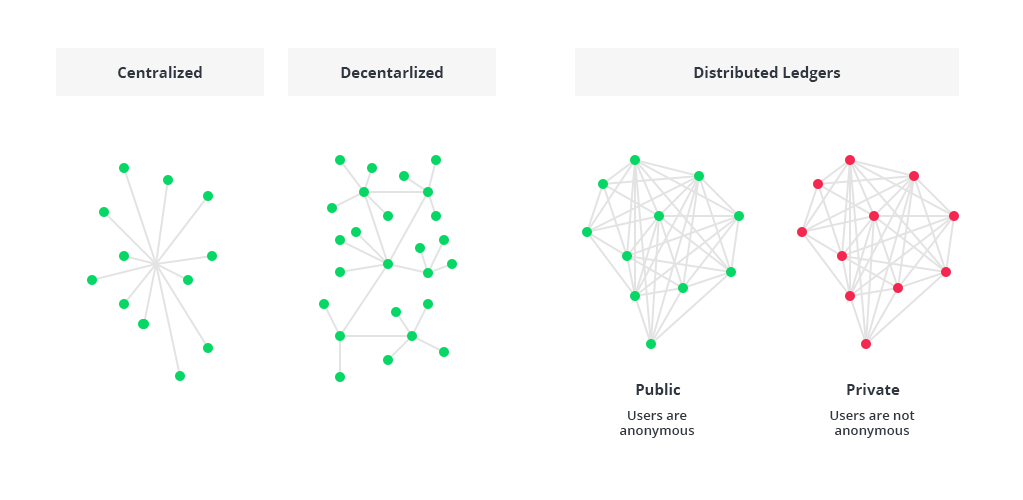Distributed Ledger
A distributed ledger is a database that is consensually shared and synchronized across multiple sites, institutions, or geographies, accessible by multiple people. It allows transactions to have public "witnesses".
The participant at each node of the network can access the recordings shared across that network and can own an identical copy of it. Any changes or additions made to the ledger are reflected and copied to all participants in a matter of seconds or minutes.
Underlying distributed ledgers is the same technology that is used by blockchain, which is the technology that is used by bitcoin. Blockchain is a type of distributed ledger used by bitcoin.
A distributed ledger stands in contrast to a centralized ledger, which is the type of ledger that most companies use. A centralized ledger is more prone to cyber attacks and fraud, as it has a single point of failure.Strong security
In distributed ledgers, the entries happen in the database without third-party involvement. After records are written into distributed ledgers, they cannot be altered by any other party. Hence, until the ledgers are distributed, the records cannot be tampered with.
Transparency
Distributed ledgers present with a high level of transparency. They allow all the stored information to be freely and easily viewable. It provides a significant amount of transparency desired by many industries.
Failure tolerance
The distributed ledgers’ inherently decentralized nature adds another layer of security. As the database is spread globally, it is difficult to attack.

Blockchain
A blockchain is a form of distributed ledger that has a specific technological underpinning. Blockchain creates an unchangeable ledger of records maintained by a decentralized network after a consensus approves all the records.
The significant difference between blockchain and DLT is the cryptographic signing and linking groups of records in the ledger that forms a chain. Furthermore, there is a chance for the public and users to determine how a blockchain is structured and run based on the specific application of blockchain.
In order for the network to run properly, the nodes must use consensus mechanisms such as:
Proof-of-Work
Proof of work (PoW) describes a system that requires a not-insignificant but feasible amount of effort in order to deter frivolous or malicious uses of computing power, such as sending spam emails or launching denial of service attacks.
Eg: Bitcoin, Ethereum, Dogecoin, Litecoin, Monero
Proof-of-Stake
The Proof of Stake (PoS) concept states that a person can mine or validate block transactions according to how many coins they hold. This means that the more coins owned by a miner, the more mining power they have.
Eg: Binance Coin, Cardano, Polkadot, Solana, Algorand
Federated Byzantine agreement
In FBA systems, each node does not have to be known and verified ahead of time, membership is open, and control is decentralized. Nodes can choose whom they trust. System-wide quorums emerge from decisions made by individual nodes.
Eg: Stellar, Ripple

Stellar
Stellar was created in 2014, after Bitcoin but before Ethereum. Stellar uses a much more environmentally-friendly syncing mechanism than either platform and was designed specifically for remittances and payments, so it has “cashlike” delays between transactions (i.e. very short) and it’s more or less free to use (transactions cost way less than a penny). Like Ethereum, Stellar allows you to issue other assets (say, a digital representation of a dollar or a peso) and to trade them very easily within the network.
Unlike almost all other blockchain systems, Stellar can connect to real-world endpoints, so people can turn their digital representations of money into something they can actually spend. Growing that network of real-world partners is a big focus for the Stellar Development Foundation.
Stellar is an open-source network for currencies and payments. Stellar makes it possible to create, send and trade digital representations of all forms of money—dollars, pesos, bitcoin, pretty much anything. It’s designed so all the world’s financial systems can work together on a single network.
Stellar has no owner; if anything it’s owned by the public. The software runs across a decentralized, open network and handles millions of transactions each day. Like Bitcoin and Ethereum, Stellar relies on blockchain to keep the network in sync, but the end-user experience is more like cash—Stellar is much faster, cheaper, and more energy-efficient than typical blockchain-based systems.